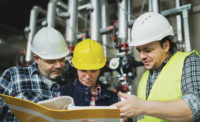As building managers make the switch from gas systems to more sustainable options across the country, Dan Rettig, senior product manager for heat pumps and sustainability at Lochinvar, says buildings have varying approaches that require a balancing act between two goals: staying in budget and meeting decarbonization goals.
Rettig says building managers are often asking contractors for three different bids: One all gas, another with electrical and resistive systems, and then option C: heat pumps.
"You look at the cost, so then people start to evaluate, maybe that's what would drive them to a straight electrical resistive product, but maybe the electrical infrastructure is not in the building. I got to pull it to the building. So then they kind of got to go through that process and evaluation. And that may lead them back to a hybrid solution where it's a mix of electric and gas," Rettig said.
As for heat pumps in a retrofit, they face a steep technical hurdle when it comes to the products available on the market.
"When you think about a typical hydronic system, a lot of them, especially retrofit, are designed around 180 delivery temperature from the boiler," Rettig said. "Heat pumps just can't get that high outlet temperature currently. And they really struggle at lower ambient.
"When do we need our boilers the most? It's when it's the coldest outside. And that's where the heat pumps currently struggle on that outlet delivery temperature. That is one thing that we are working through as an industry, getting a product out there to meets their needs," Rettig said.
While many companies and institutions are aiming for ambitious decarbonization goals, old buildings are limited in their cost effective options.
Rettig noted how the answer to a particular question may change a building's mechanical system retrofit plans.
"Is this driven by local legislation that says I can't have gas? Or is this maybe, a goal of the corporation or the business unit that you're working with to lower their carbon footprint?" he asked, noting that lowering emissions by 50% instead of 100% may be satisfactory for all parties depending on circumstance and dispensation.
Rettig added that Lochinvar's philosophy with retrofits that are taking a piece-meal approach to decarbonization is that the newer, higher efficiency equipment ought to be treated as a "workhorse," with older equipment held in reserve.
"When you need the higher outlet temperatures, which then your high-efficiency products are not likely in those condensing temperatures anyway, you can bring on your backup, non-condensing units, and it kind of is a flush," Rettig concluded.
To learn more, watch the video or listen to our extended podcast interview with Rettig.




